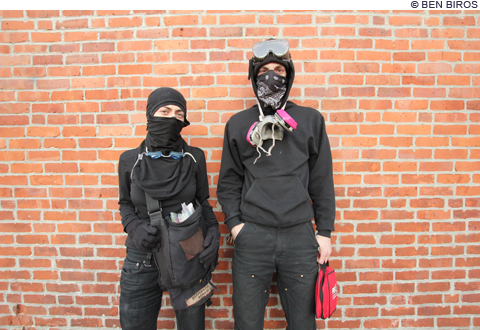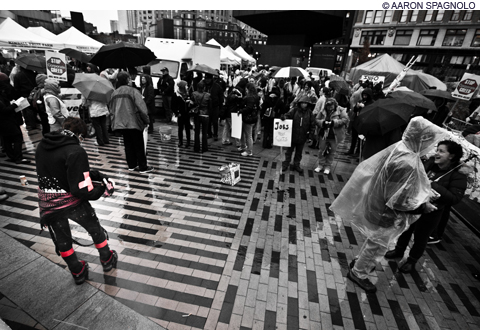
DR. WHO? Although what they do is legal in Massachusetts, many street medics insist on hiding their identity, in case their work puts them at odds with the police.
|
April 25, 2009: outside of the IMF/World Bank meeting in Washington, DC, police with batons are attacking a group of protesters. Above a roar of chaos and confusion, one activist screams in pain: stomped by a cop, he's suffering from an excruciating break just below the knee.A trained EMS team is standing 20 feet away, but the police aren't letting any medical workers through. The injured demonstrator's only resource is a team of street medics — fellow radicals, armed with basic first-aid knowledge. In all-black outfits with red duct-tape crosses on their sleeves, they quickly surround the guy and hustle to construct a makeshift splint.
Anarchistic, high-energy, and self- organized, street medics have been part of activist counterculture since the 1960s, with major presences at civil-rights protests, anti–Vietnam War actions, the American Indian Movement's occupation of Wounded Knee in 1973, anti-globalization protests in the 1990s and early aughts, and most recently, at Occupy encampments internationally. Street medics also take their skills to disaster areas: there were medics in New Orleans after Hurricane Katrina and in Haiti after the earthquake.
Some medics have formal EMS training, but most are just trained by other medics. In typical "fuck the system, let's build our own world" punk fashion, they reject the necessity of legal medical licensing. Instead, over the decades, they've amassed their own set of traditions and protocols, their own collectives and conferences.
Ask any street medic, and they'll tell you their free, direct-action health care is protected by Good Samaritan laws — laws designed to deflect liability from bystanders who respond to emergencies. But it's unclear whether those laws apply to medics, who go into protests specifically prepared to give medical care.
"Street medics, when they're marked as street medics, are generally expected to be tactically neutral," says "Errico," a 23-year-old street medic who lives in an Allston collective (like several medics we spoke to, Errico asked that we not use his real name). "We tend to discourage people who are wearing street-medic insignia from, for example, throwing bricks at cops . . . but we are in no way politically neutral. Medics exist to further the movement."

FROM SELMA TO SOUTH STATION The street-medic effort has its roots in the civil-rights activism of the 1960s, but many feel that the Occupy protests have taken the work to a new level of popularity — and have attracted professional medical workers to the movement. |
RADICAL ROOTSThe first street medics organized in 1964, during the civil-rights movement, as part of the Medical Presence Project — a working group of the Medical Committee for Human Rights. MCHR was made up of physicians, mostly white and Northern, who organized to provide medical care for activists and volunteers working in Mississippi during the Freedom Summer. (Often, segregated hospitals would deny care to injured protesters).
Members of the Medical Presence Project were doctors, registered nurses, and medical students, who specifically showed up whenever there was an expectation of violence being used against civil-rights activists. Initially, they wore white lab coats as they ran side by side with protesters.